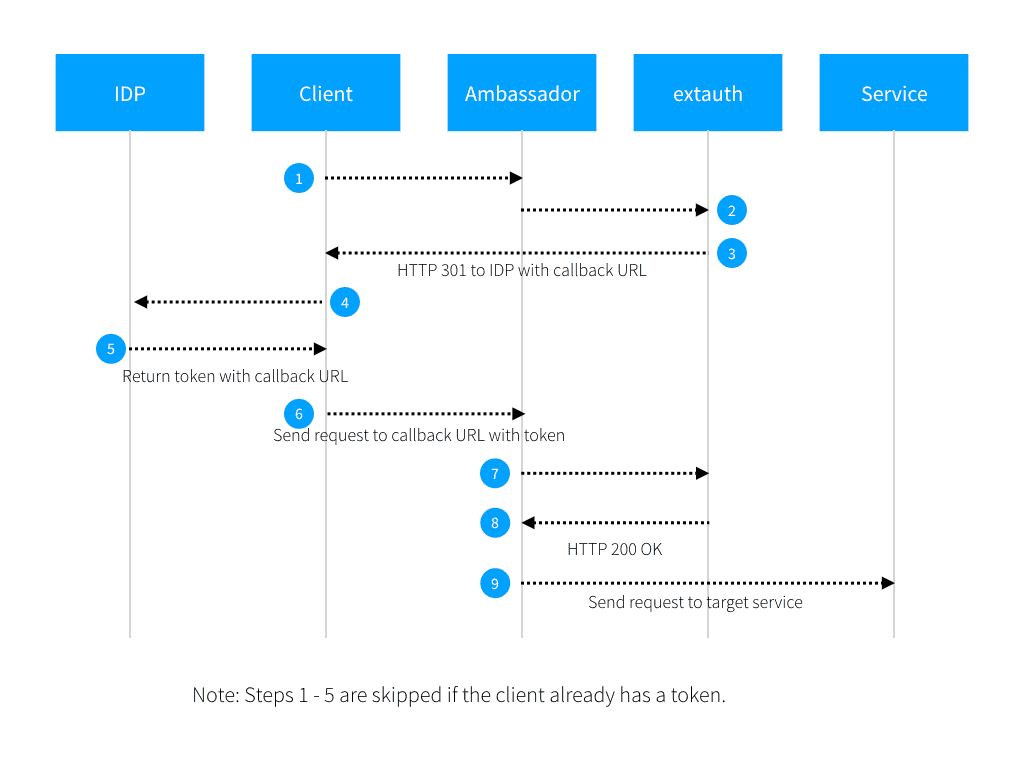DocsEdge Stack
ExtAuth protocol
ExtAuth protocol
By design, the ExtAuth protocol used by the AuthService and by External Filters is highly flexible. The authentication service is the first external service invoked on an incoming request (e.g., it runs before the rate limit filter). Because the logic of authentication is encapsulated in an external service, you can use this to support a wide variety of use cases. For example:
- Supporting traditional SSO authentication protocols, e.g., OAuth, OpenID Connect, etc.
- Supporting HTTP basic authentication (see a sample implementation).
- Only authenticating requests that are under a rate limit and rejecting authentication requests above the rate limit.
- Authenticating specific services (URLs), and not others.
For each request, the ExtAuth service may either:
- return a direct HTTP response, intended to be sent back to the requesting HTTP client (normally denying the request from being forwarded to the upstream backend service) or
- return a modification to make to the HTTP request before sending it to the upstream backend service (normally allowing the request to be forwarded to the upstream backend service with modifications).
The ExtAuth service receives information about every request through Ambassador Edge Stack and must indicate whether the request is to be allowed or not. If not, the ExtAuth service provides the HTTP response which is to be handed back to the client. A potential control flow for Authentication is shown in the image below.
Giving the ExtAuth service the ability to control the response allows many different types of auth mechanisms, for example:
- The ExtAuth service can simply return an error page with an HTTP 401 response.
- The ExtAuth service can choose to include a
WWW-Authenticateheader in the 401 response, to ask the client to perform HTTP Basic Auth. - The ExtAuth service can issue a 301
Redirectto divert the client into an OAuth or OIDC authentication sequence. The control flow of this is shown below.
There are two variants of the ExtAuth: gRPC and plain HTTP.
The gRPC protocol
When proto: grpc is set, the ExtAuth service must implement the Authorization gRPC interface, defined in Envoy's external_auth.proto.
The HTTP protocol
External services for proto: http are often easier to implement, but have several limitations compared to proto: grpc.
- The list of headers that the ExtAuth service is interested in reading must be known ahead of time, in order to set
allow_request_headers. Inspecting headers that are not known ahead of time requires instead usingproto: grpc. - The list of headers that the ExtAuth service would like to set or modify must be known ahead of time, in order to set
allow_authorization_headers. Setting headers that are not known ahead of time requires instead usingproto: grpc. - When returning a direct HTTP response, the HTTP status code cannot be 200 or in the 5XX range. Intercepting with a 200 or 5XX response requires instead using
proto: grpc.
The request From Ambassador Edge Stack to the ExtAuth service
For every incoming request, a similar request is made to the ExtAuth service that mimics the:
- HTTP request method
- HTTP request path, potentially modified by
path_prefix - HTTP request headers that are either named in
allowed_request_headersor in the fixed list of headers that are always included - first
include_body.max_bytesof the HTTP request body.
The Content-Length HTTP header is set to the number of bytes in the body of the request sent to the ExtAuth service (0 if include_body is not set).
ALL request methods will be proxied, which implies that the ExtAuth service must be able to handle any request that any client could make.
Take this incoming request for example:
The request Ambassador Edge Stack will make of the auth service is:
The response returned from the ExtAuth service to Ambassador Edge Stack
If the HTTP response returned from the ExtAuth service to Ambassador Edge Stack has an HTTP status code of 200, then the request is allowed through to the upstream backend service. Only 200 indicates this; other 2XX status codes will prevent the request from being allowed through.
The 200 response should not contain anything in the body, but may contain arbitrary headers. Any header present in the ExtAuth service' response that is also either listed in the
allow_authorization_headersattribute of the AuthService resource or in the fixed list of headers that are always included will be copied from the ExtAuth service's response into the request going to the upstream backend service. This allows the ExtAuth service to inject tokens or other information into the request, or to modify headers coming from the client.The big limitation here is that the list of headers to be set must be known ahead of time, in order to set
allow_request_headers. Setting headers that are not known ahead of time requires instead usingproto: grpc.If Ambassador Edge Stack cannot reach the ExtAuth service at all, if the ExtAuth service does not return a valid HTTP response, or if the HTTP response has an HTTP status code in the 5XX range, then the communication with the ExtAuth service is considered to have failed, and the
status_on_errororfailure_mode_allowbehavior is triggered.Any HTTP status code other than 200 or 5XX from the ExtAuth service tells Ambassador Edge Stack to not allow the request to continue to the upstream backend service, but that the ExtAuth service is instead intercepting the request. The entire HTTP response from the ExtAuth service--including the status code, the headers, and the body--is handed back to the client verbatim. This gives the ExtAuth service complete control over the entire response presented to the client.
The big limitation here is that you cannot directly return a 200 or 5XX response. Intercepting with a 200 of 5XX response requires instead using
proto: grpc.






